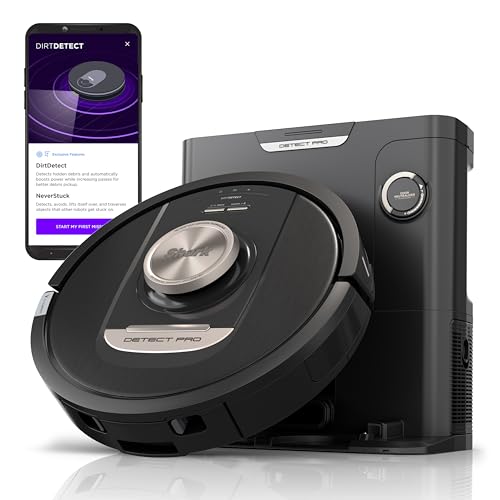
Robot Vacuum Mops
Add a review FollowOverview
-
Founded Date October 5, 1992
-
Sectors Education & Training
-
Posted Jobs 0
-
Viewed 53
Company Description
5 Things That Everyone Doesn’t Know On The Subject Of Best Robot Vacuum 2023
The Best Robot Vacuum 2023
Robot vacuums can make cleaning your floors a breeze. The best Robot floor mop ones can remove tracked-in dirt, crumbs and shed pet hair and more.
And while they still can’t do the same job as a regular vacuum, they’ve come a long way over the last few years. They’re smarter, more powerful and (marginally) better at avoiding chairs.
Smart Mapping
Utilizing navigation tools such as lasers and sensors, robotic vacuum cleaners move around your home, removing pet hair, crumbs, and dirt into their dustbins from hard floors such as laminate, wood and tile and carpets and area rugs with low pile. The most advanced robots can map your house, to help them remember where they have been and avoid bumping into obstacles like sofas, chairs and bookshelves that you might want to keep out of your way. You can also set up no-go areas on your smartphone to tell your robot to avoid rooms you don’t wish it to clean.
Robots with advanced mapping abilities, such as the Roomba J7, utilize an onboard camera and processor-powered intelligence to avoid and detect obstacles. It can then be left to do a thorough job without having to continuously monitor the status of your floorplan or manually remove obstacles from the robot’s way. The TP Link Tapo RV30 plus is a robot that can combine mopping and vacuuming, which means it’s a one-stop solution for keeping your home clean. It’s got great suction, and it is compatible with Alexa and Google Assistant. It also has a convenient self-emptying feature and can be used as a security camera.
Roborock Q Revo, a lower-cost robot that vacuums, mops and functions as an automated trashcan, is a good option for homes that do not require for more advanced features. It does have some disadvantages when compared to the Roomba S8 and j7. It uses a single brush instead of dual roller brushes, meaning it isn’t as effective in removing larger objects like socks and shoes. It doesn’t come with AI obstacle avoidance, so it is possible that you will need to eliminate clutter before running.
The iLife A4s Pro robot is a simple reliable and reliable robot that is ideal for those who appreciate simplicity and efficiency. It costs less than $200 and provides consistent, strong suction on hardwood and carpets with low pile, while avoiding tangles with rug threads. It doesn’t include any advanced features, however it does the job well. It’s also compatible with voice commands, which means you can set it up on schedule or even set up zones that are not allowed to enter using the app.
Object Detection
Object-avoidance technology can impact the ability of a robot vacuum navigate through your home. Some models on this list include sensors (or cameras) to aid your robot vacuum to avoid common traps for robots like cords, toys for kids and pet mess. The iRobot Roomba j7 is one of the most impressive examples of this kind of smart tech in action. It also has a stylish base that automatically empty the dustbin so you don’t have to.
In our testing, we set up the robotic cleaner in a large home and were awed by how quickly and efficiently the floors were cleaned without getting sluggish. It is very maneuverable and can reach places that most standup vacuums cannot reach, like under couches and under beds. It comes with a 500-ml dustbin, a powerful suction system and a running time of more than two hours. However, it isn’t equipped with the ability to set no-go zones within the app and its detection of objects is a little hit-or-miss which means that we saw it occasionally bump into objects during our tests (resulting in a few tipped vase tops).
It’s important to keep in mind that despite how smart a robot vacuum might be, it won’t completely replace your traditional canister or upright vacuum. It can’t deal with heavily soiled carpets, it won’t reach into every crevice, and won’t be able to reach your ceilings or other hard-to-reach spaces. It’s a great addition to your routine cleaning to remove pet dander, and hair.
Most robot vacuums come with sensors that aid them to navigate around obstacles and stairs. They can sense when they’re about fall down the stairs, for instance, and can also recognize areas that are cluttered and move around them. If you’re not careful your robot-cleaner could get stuck on a shoe, cord or another object.
Some robot vacuums come with mapping capabilities that permit them to draw an accurate floor plan of your home and also locate themselves. They can then identify which areas they have already cleaned and can save time by not having to go over the same spots. It also lets them continue the same place they left off, should they have to return to their charging dock.
Self-Emptying
A robot vacuum that automatically empties its bin of dust when it’s full is an incredible benefit. Some models come with windows that allow you to observe when the bin has to be empty. This is a fantastic feature for those with pets or children who make more mess than adults.
Most robot vacuums let you choose whether the machine is controlled by a remote, an app for your smartphone, or by voice commands. They also have a variety of digital features, including maintenance and scheduling. You can program your robot to clean your house on a weekly or regularly, using the right settings. You can also program it to map and clean certain areas of your house.
The smartest robot vacuums that we’ve tested are equipped with cameras and smart sensors, which enable them to create maps of your home. These can be saved in the robot’s application so that you can quickly navigate to specific rooms or areas of your home. Some of these systems will even keep track of the furniture’s layout and transitions between hardwood floors and carpet.
Smart vacuums help you save time by mapping and cleaning entire homes in a timely manner and keeping detailed records about the previous cleaning sessions. You can access the records via an app that you can install on your tablet or smartphone. Many can also connect to your smart speaker so you can control them with voice commands.
TP-Link Tapo RV30+ is a self-emptying robot that offers outstanding performance for a reasonable cost. It can clean hardwood floors and low-pile carpets, and remove pet hair and other debris. It’s not as advanced as other robots that we’ve reviewed, but it does the job well.
The model’s tanks-like wheels allow it to roll over obstacles such as cords that are tangled and high transitions within rooms. It has a huge bin that doesn’t have to be emptying manually and it can charge itself and restart cleaning when it’s running out of power. It’s more expensive than the other robotic vacuums that we’ve tested but it is able to combine powerful suction and simple controls to deliver an excellent value.
Voice Control
Most robot vacuums are controlled via a remote control or an app for a smartphone. Certain robot vacuums are controlled by voice commands through smart speakers, such as Amazon Echo or Google Home. This is helpful if your robot needs to be cleaned and you have pets or small children who might interfere.
The majority of models have an automatic mode that works without any input from you. Simply press a button on the robot or within the app, and it will start sucking up dirt, food crumbs, and pet hair. They can be programmed to clean on a regular schedule and is perfect for those who wish to make it easy to set it and forget it.
Certain models that are more expensive come with an advanced feature which uses artificial intelligence to detect and scan the presence of obstacles within your home. These models can recognize things like stairs, furniture power cords, even different types of flooring. This can help them avoid these hazards, which is especially useful in larger homes with lots of carpets and floor coverings that are hard for robots to navigate.
Other robots are less sophisticated in their object detection abilities, but they are still able to do the job. The TP-Link Tapo RV30 Plus, for example, has the appearance of WiFi routers, but it has the performance of a premium bot. It has a strong suction that can take care of dirt and debris on medium-pile flooring and carpet. Its short, squat side brushes are less likely to become caught in stray shoes and cords and its hybrid roller brush utilizes bristles and plastic rather than bristles in traditional form for a more thorough cleaning.
The model is more expensive than other robots in the mid-range, but it does everything you would expect from a robot mop and vacuum. It can create the cleaning schedule and then create one. It also has virtual zones to keep out of. However, it does not have room-scanning or obstacle avoidance like the j7 and S8.
